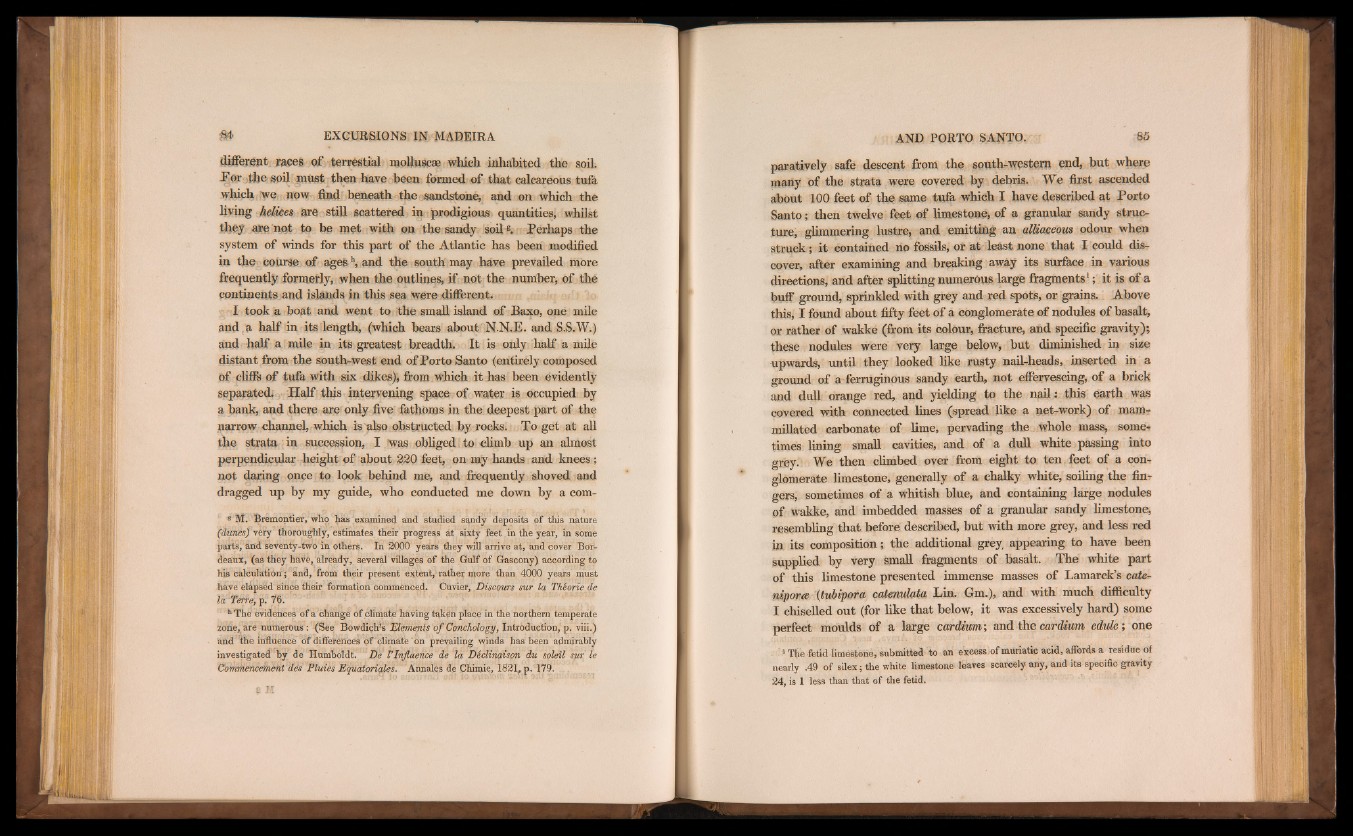
different races of terrestial njofiuscæ which inhabited the soil.
P’or the soil must then have been formed of that calcareous tufa
which we now find beneath the sandstone, and on which the
living helices are still scattered in prodigious quantities, whilst
they are n©t to be met with on the sandy soil Ai Perhaps the
system of winds for this part of the Atlantic has been modified
in the course of agesh, and the south may have prevailed more
frequently formerly, when the outlines, if not the number, of the
continents and islands in this sea were different.
I took a boat and went to the small island of Baxo, oné mile
and a half in its length, (which bears about N-NJE. and S.S.W.)
and half a mile in its greatest breadth. It is only half a mile
distant from the south-west end of Porto Santo (entirely composed
of cliffs of tufa with six dikes), from which it has been evidently
separated. Half this intervening space of water is occupied by
a bank, and there are only five fathoms in the deepest part of the
narrow channel, which is also obstructed by rocks. To get at all
the strata \ in succession, I was obliged to climb up an almost
perpendicular height of about 220 feet, on my hands and knees ;
not daring onçe to look behind me, and frequently shoved and
dragged up by my guide, who conducted me down by a com-
! M. Bremontier, who has examined and studied s^ndÿ deposits of this nature
(dunes) very thoroughly, estimates their progress at sixty feet in the year, in some
parts, and seventy-two in others. In 3000 years they will arrive at, and cover Bor.
deanx, (as they have, already, several villages of the Gulf of Gascony) according to
his calculation ; and, from their present extent, rather more than 4000 years must
have elfps'éd since their formation commenced. Cuvier, Discours sur lu Théorie de
la Térre, p. 76.
h The evidehces of a change of climate having takën place in the northern temperate
zone, are numerous : (See Bowdieh’s Tilimu'jils of Concholopy, Introduction, p. viii.)
and 'the influence of differences of çlimâfe on prevailing winds has been admirably
investigated by de Humboldt. Da rlnflnenct' de la Déclinçrlson du soleil spr le
Commencement des Pluies Equatoriales. Annales de Chimie, 1821, p. 179.
paratively safe descent from the south-western end, but where
many of the strata were covered by debris. We first ascended
about 100 feet of the same tufa which X have described at Porto
Santo; then twelve feet of limestone, of a granular sandy structure,
glimmering lustre, and emitting an alliaceous odour when
struek; it contained no fossils, or at least none that I could discover,
after examining and breaking away its surface in various
directions, and after splitting numerous large fragments'; it is of a
buff ground, sprinkled with grey and red spots, or grains. Above
this, I found about fifty feet of a conglomerate of nodules of basalt,
or rather of wakke (from its colour, fracture, and specific gravity);
these nodules were very large below, but diminished in size
upwards, until they looked like rusty nail-heads, inserted in a
ground of a ferruginous sandy earth, not effervescing, of a brick
and dull orange red, and yielding to the nail: this earth was
covered with connected fines (spread like a net-work) of mam-
m lllatPfl carbonate of lime, pervading the whole mass, sometimes
fining small cavities, and of a dull white passing into
grey. We then climbed over from eight to ten feet of a conglomerate
limestone, generally of a chalky white, soiling the fingers,
sometimes of a whitish blue, and containing large nodules
of wakke, and imbedded masses of a granular sandy limestone,
resembling that before described, but with more grey, and less red
in its composition; the additional grey, appearing to have been
supplied by very small fragments of basalt. The white part
of this limestone presented immense masses of Lamarck’s cate-
niporee (tubipora, cdteuulutd Lin. Urn.), and with much difficulty
I vbl^llprl out (for like that below, it was excessively hard) some
perfect moulds of a large cardium; and the cardium edule; one
1 The fetid limestone, submitted to an excess of muriatic acid, affords a residue of
nearly .49 of silex; the white limestone leaves scarcely any, and its speciflc gravity
24, is 1 less than that of the fetid.